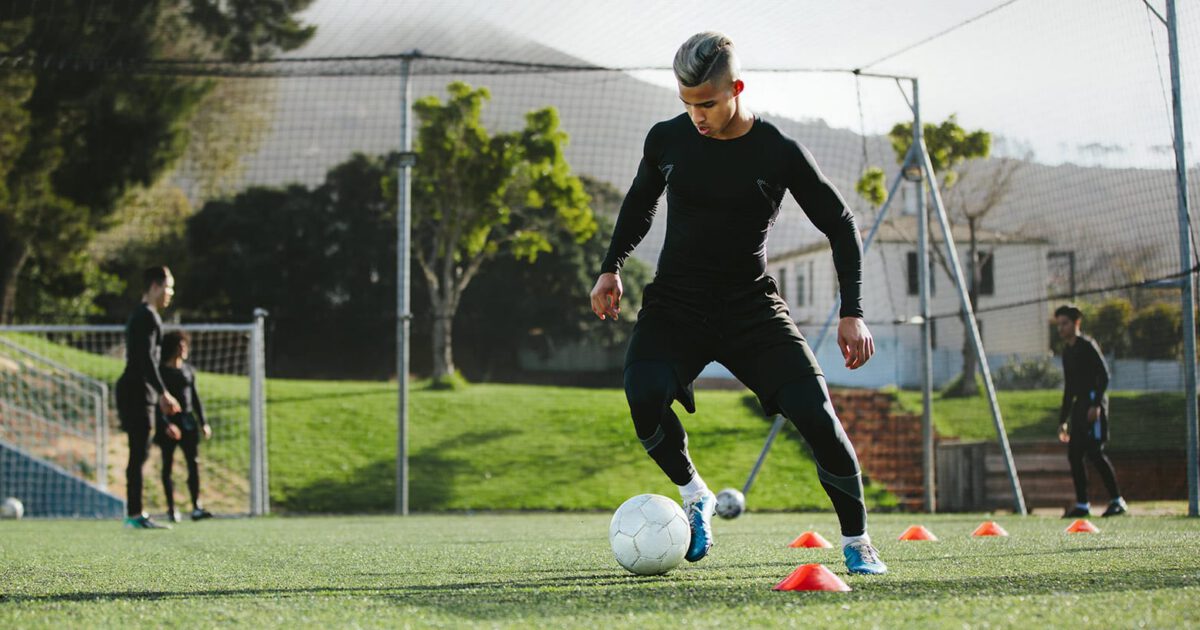Football moves millions and with good reason. It’s challenging, fast-paced, engaging and its players have earned the recognition as sports stars. Long gone are the days when football players would smoke or drink alcohol. The level of proficiency is as demanding as in any professional sport. And now the football “Olympics” are here! The World Cup is taking center stage and grabbing everyone’s attention and there is no reason you shouldn’t get in mood with some football workout exercises.
At EVO we understand the importance of optimizing efforts to bring the best results. So, if you’re a football player looking for an alternative workout or just wanting to get into the football mood, this football workout plan is for you.
5 BENEFITS OF FOOTBALL WORKOUT ROUTINES
1. Move skillfully
Train agility and speed with the right “stepping stones”. Push yourself by timing your performance while dodging obstacles.
2. Coordination and balance
You’ll need it. Train the constant inversions, sudden changes in motion and interruptions. These can be practiced against a wall with a medicine ball, with a bosu and at the Kinesis station.
3. Strength
When you push yourself with extra weights in practice you’ll feel an extra boost of stamina when facing real competition without the added effort. Ankle weights or barbells “supporting” your squats and lunges will be the extra push that will make everything else seem easy.
4. Proprioception
Understanding where you are in the game at all times, knowing your relation to others, your location in the field and in relation to the ball are all instant information pieces that the brain captures and that is mandatory for a good performance. Awareness of the surrounding environment can be trained.
5. Play
The best thing about football is that it’s a game. It’s fun. There are no repetitions of tedious sets – there is the constant challenge and the brain loves creativity and dare. Keeping curiosity and investing in innovation in your workout will keep you wanting more so go for different. Mix yoga or wall climb in your circuit to keep it interesting.
FOOTBALL WORKOUT
- 9 exercises
- Minimum: 2 sets
1. Ankle mobility
10 minutes
This exercise will be needed for all other movements of this football workout plan.
2. Lateral jumps
1 minute
In the game, the so-called “cutting” is a rapid slow down of the body while the body’s center must equilibrate to move further into another direction. Required is mobility in the ankle and/or hip joints and core strength. If your upper body moves further then your braking foot there is a lack of core strength. Don’t rotate your feet external, it will put wrong shear forces on your knees and you’ll be slower.
3. Suspended lunge with hop
40 sec / leg
Jumps require a mixture of strength and speed. These dynamic exercises activate the central nervous system and activate the fast-twitch muscle fibers (which contract quickly) to work more easy and efficient. So-called plyometric movements use the stretching and shortening cycle, which is a stretch reflex of rapid elongation of the muscle followed by a rapid muscle shortening. The SSC use this reflex to generate powerful movements out of this stored elastic energy.
4. Side shuffle
1 minute
Furthermore, plyometric training improves the ability to coordinate movements, especially shift in directions. If you save and release elastic energy you generate far more pace and strength while decreasing energy expenditure and increase endurance.
5. Bunny hops
1 minute
Most training methods for athletes and hobby sportsmen/women take place in an upright position (like the exercises before). The so-called ground-based exercises and workout flows on the ground are a good alternative for every training program. These exercises are not performed standing but instead for example horizontally or crawling.
It provides a better movement intelligence, control and dynamic. The reactivation of former patterns, which we once learned and then unlearned, is a central part of this diversified body weight training. As mentioned above functional movement is controlled by input of proprioceptors.
6. Side to side shuffle with floor touch
1 minute
If you move well in lateral jumps, this exercise adds some new proprioceptive impact.
7. High hurdle jump
40 seconds
This is another plyometric exercise with an obstacle. You will learn to put as much force as quickly as possible into the ground in a very challenging exercise.
8. MB twist slam
1 minute
If you have a lack of strength and speed, medicine ball slams improve your performance. It trains your explosiveness (rapid strength). The medicine ball can be used to improve your skill to transfer energy from one end of the body to the other end, the so-called kinetic chain.
9. Lunge Jump
45 seconds
Lunge jumps will improve your skill to coordinate movement. Jumps require a mixture of strength and speed. These dynamic exercises activate the central nervous system and activate the fast-twitch muscle fibres (which contract quickly) to work more comfortable and efficient. So-called plyometric movements use the stretching and shortening cycle, which is a stretch reflex of rapid elongation of the muscle followed by a rapid muscle shortening. The SSC use this reflex to generate powerful movements out of this stored elastic energy. NOTICE: The more dynamic the exercise, the more important is the elasticity. The slower the movement, the bigger the focus on stability and strength.
Workout developed by EVO expert Bardo Tschapke, EVO Le Flair Düsseldorf
Follow Bardo on Instagram: healthcoachbardo and Facebook: Health Coach Bardo
